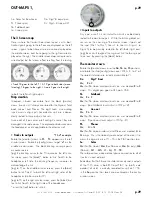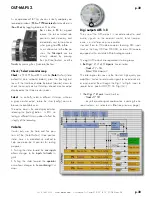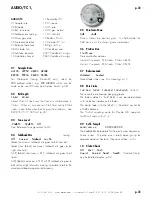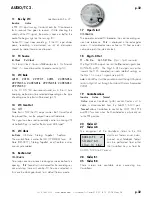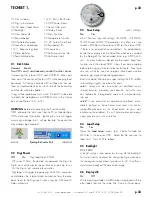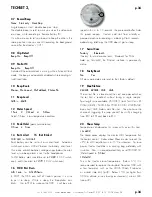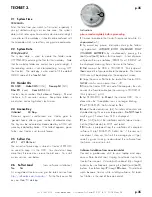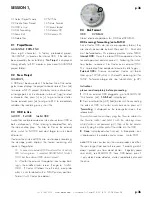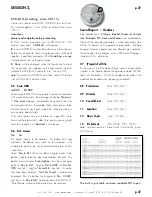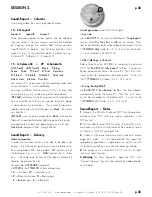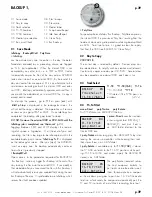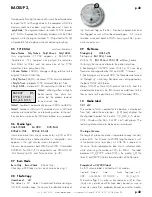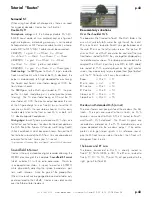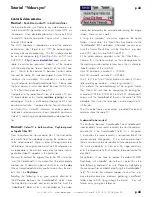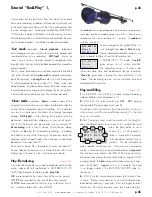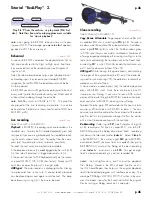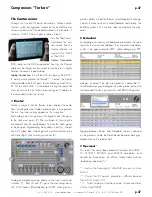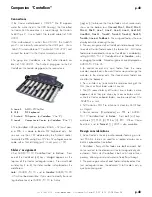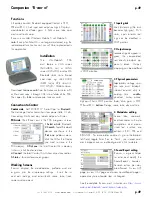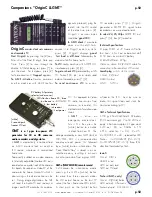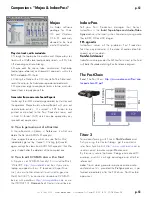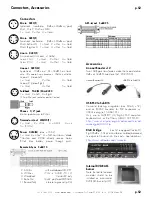
+33 4 7642 9550
www.aaton.com
User manual for Cantar-X1 & X2 v2.15 2008 March 28
p.43
p.43
Surround 5 .1
When using SoundField or Schoeps mics, there is no need
for a special decoder; Cantar has it all, built-in!
Double M/S*
Microphone wiring:
with the Schoeps double M/S (L-C-
R-SL-SR) head made of two cardioid and one figure-of-
eight microphones, a decoding accessory is not needed.
Schoeps delivers an XLR 7 extension cable to which a home-
made XLR 7 to XLR 5/XLR 3 Y cable should be connected.
• XLR 7
(F) 1 = gnd 2 = +Mfront 3 = –Mfront
4 = +Sfront 5 = –Sfront 6 = +Mrear 7 = –Mrear
• XLR 5
(M) 1 = gnd 2 = +Mfront 3 = –Mfront
4=+Sfront 5 = –Sfront (yellow, red labels)
• XLR 3
(M) 1 = gnd 2 = +Mrear 3 = –Mrear (grey)
Track routing:
the
XLR 5
goes to Mic 3/4 inputs routed to
Track 3 and Track 4 which should be M/S declared; the
output is automatically left/right decoded for monitoring.
The Track 3 and Track 4 mixer faders being at 100%, the
front stereo is heard.
The
XLR 3
goes to the Mic 5 input routed to T 5; the pan-
pot for this track should be put in central position (mono
listening). The T 3 mixer fader being at 0% and the T 5
mixer fader at 100%, the monitor output becomes the sum
of the S figure-of-eight mic on Track 4 (a+ a–) and the M
rear mic on Track 5, the rear stereo is heard. It is thus easy
to alternately listen to the front or rear M/S; or both with
5.1 double capsule headphones.
Mixing stage:
launch Pyramix and make two M/S strips, one
for the front, one for the rear: lay down the three track media on
the M/S Tracks (the Pyramix CW center width), copy Track 2
«S front» onto Track 4, which becomes «S rear». Reinject the M
front onto the surround of the M/S front. You can also make an
extraction for the ‘sub’: here is your 5.1 sound!
*A proposition of Francois Musy and Gabriel Hafner, NSM Switzerland.
Soundfield
B-Format
Cantar is the only on-location digital recorder allowing the
STEREO monitoring of the ‘complete’
Soundfield B-Format
(which includes 5.1) with no extra accessories. Thanks to
its on-board mixer sliders, it is easy to monitor in STEREO
while dynamically adjusting the ‘space’ parameters : pat-
tern, width, rotation. Since the gain of the preamplifiers
(Mic or Line level) can be ganged to one master fader only
and monitored to the half dB, Cantar insures total control
over the B-format later treatments.
Documentary situations
Over the shoulder M/S
The boom on Mic 5 routed to Track 1 (the Mic 5 fader is the
one which naturally falls under the right hand), the ‘calm’
RF mic on Line-in 1 routed to Track 2: you get the boom and
the calm RF mic on the left circular screen. The ‘active’ RF
mics on Mic 1 and Mic 2 are under the control of the two
front faders; routed to T3 T4 they are together displayed on
the middle circular screen. The stereo pair connected to the
coupled Mic 3 Mic 4 inputs (only one XLR 5 to XLR 5 cable)
are routed to T5 T6 and displayed on the right circular
screen; they momentarily let you replace them ([eye] button)
with the T7 T8 tracks which carry the mixdown.
Boom
> Mic 5 > T1
RF mic, calm > Lin 1
> T2
RF1 active
> Mic 1 > T3
RF2 active
> Mic 2 > T4
Stereo-L or M > Mic 3 > T5
Stéreo-R or S > Mic 4 > T6
Mixdown with decoded M/S (or not)
The mixer faders and pan-pots feed the mixdown (Xa Xb)
tracks. The inputs are routed to the six tracks; an M/S
couple is connected to Mic3 & Mic4, routed to Track 5
and Track 6, M/S declared. The M and S signals are
recorded as metered on the T5 T6 modulometers and
stereo decoded into the mixdown output. If the editor
prefers not to get stereo signals in his reference sound,
pan the M Track to one side or the other: the S Track will
disappear from the mix.
The boom and RF mics:
The boom, connected to Mic 5, is directly routed to
Track 7 (T7 T8 IN-GRIDS, p.28). The RF mics, routed to
Tracks T1, T2, T3, T4, T5 and T6, all pan-potted to the
right, go to Xb (Track 8).
Tutorial "Routes"

